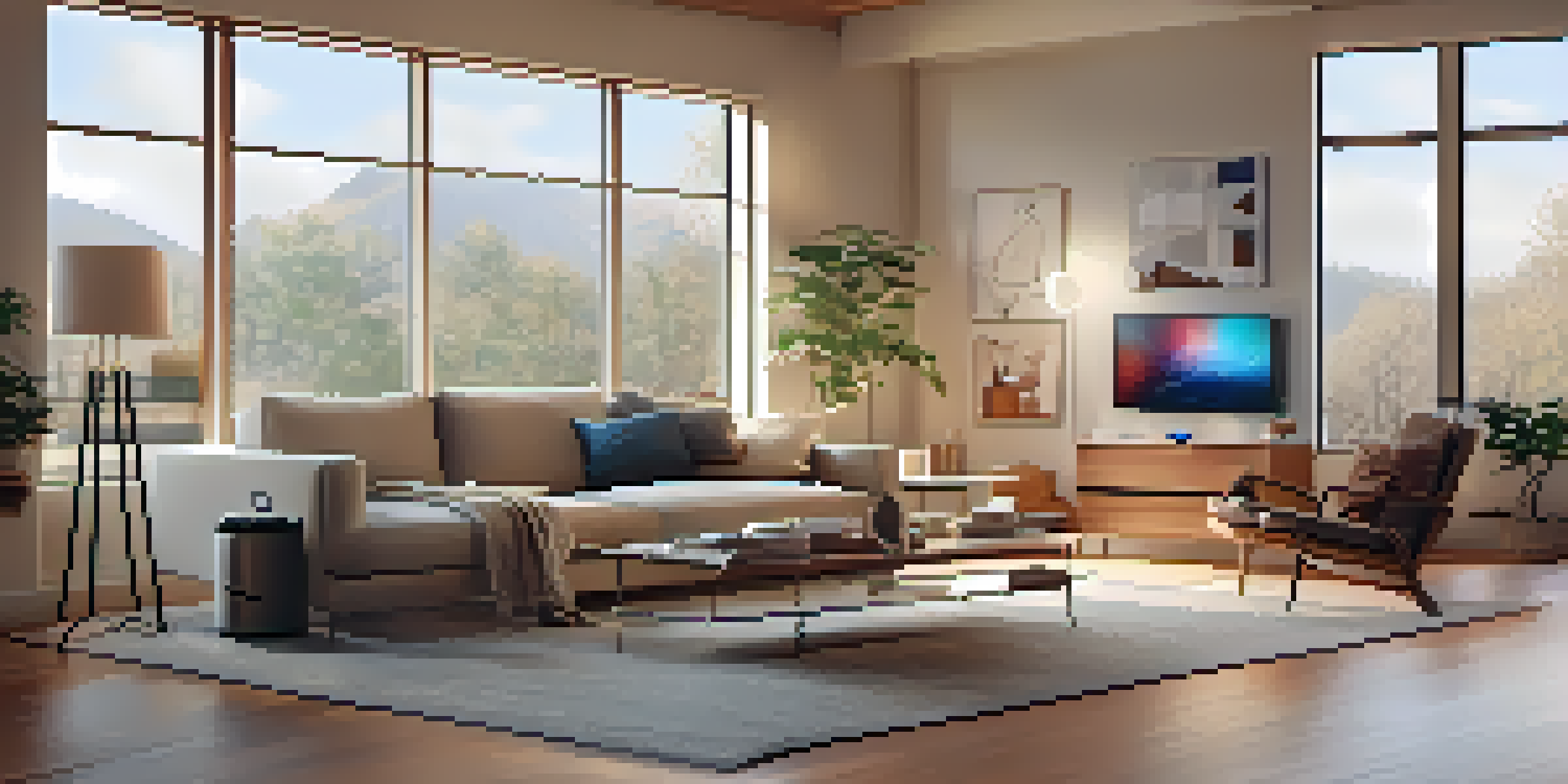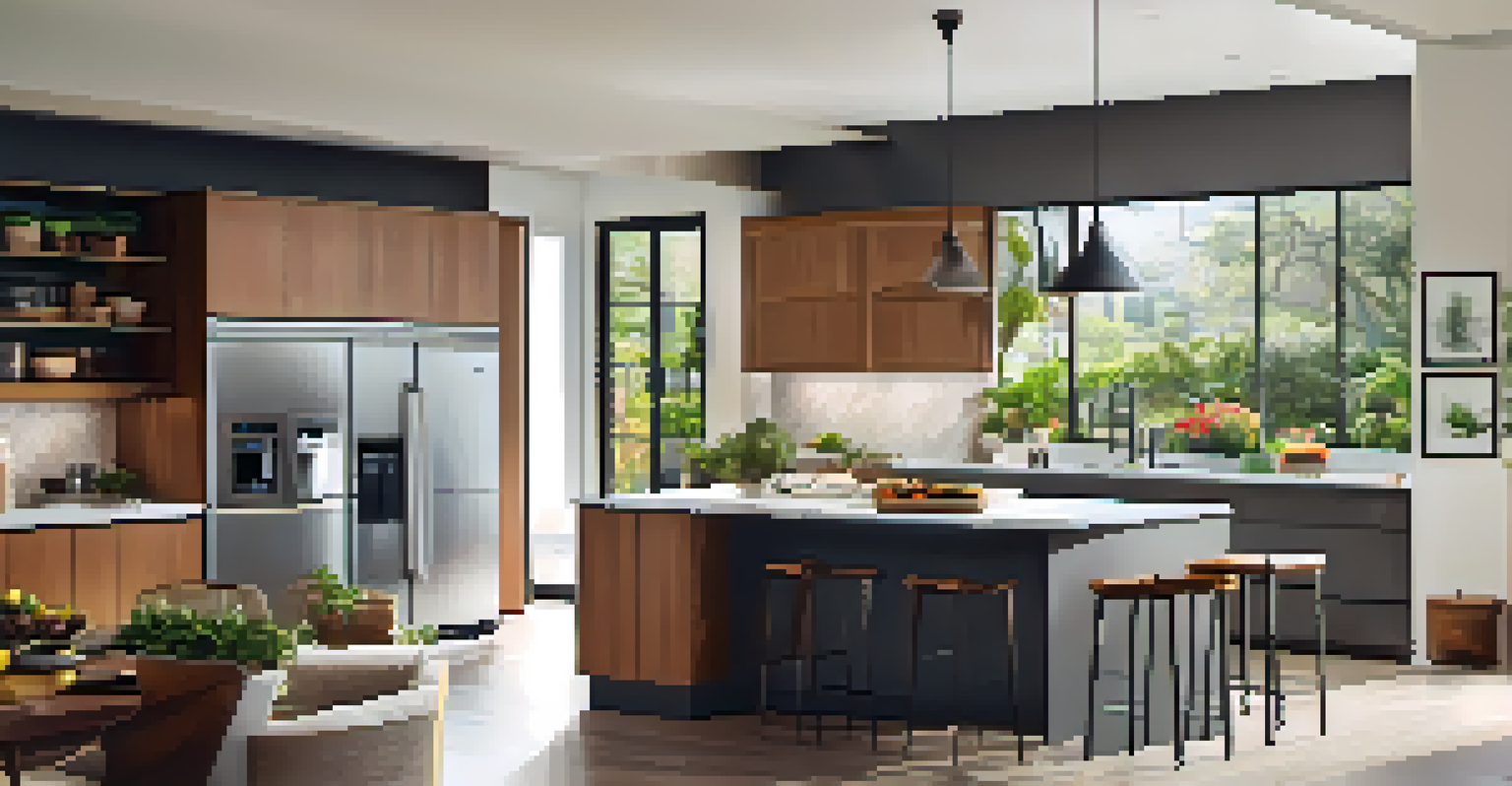Integrating Smart Home Devices with Home Automation

Understanding Smart Home Devices and Their Benefits
Smart home devices are electronic gadgets connected to a network and can be controlled remotely. They offer convenience, such as adjusting the thermostat or lighting with just a tap on your phone. By integrating these devices, you can create a cohesive system that enhances your daily life.
The best way to predict the future is to invent it.
The benefits of these devices extend beyond mere convenience; they can also improve energy efficiency and security. For instance, smart thermostats learn your schedule to optimize heating and cooling, reducing utility bills. Similarly, smart cameras and doorbells enhance home security by allowing you to monitor your property in real-time.
Embracing smart technology means transforming your home into a more responsive environment. Imagine a home that anticipates your needs, adjusting settings as you arrive or leave. This integration not only elevates comfort but also streamlines daily routines.
Choosing Compatible Smart Home Devices
Not all smart home devices work seamlessly together, making compatibility a crucial factor in your selection process. Devices should ideally support common communication protocols, such as Zigbee, Z-Wave, or Wi-Fi. By choosing compatible devices, you can ensure they can communicate effectively within your home network.

Researching brands and their ecosystems is vital as well. Many companies, like Google and Amazon, offer a range of devices that work harmoniously together, simplifying the integration process. For example, if you start with a smart speaker, consider adding lights or plugs from the same brand for smooth functionality.
Always check for third-party integrations, too. Solutions like IFTTT (If This Then That) allow you to create custom automations between devices from different brands, expanding your smart home’s capabilities beyond the basic setups.
Setting Up a Smart Home Hub for Central Control
A smart home hub acts like the brain of your home automation system, allowing you to control various devices from a single interface. Hubs can simplify your experience by aggregating multiple devices and enabling more complex automations. For example, you can set routines that control lights, locks, and thermostats at once.
Technology is best when it brings people together.
Choosing the right hub depends on the devices you already own or plan to purchase. Popular options include Samsung SmartThings and Amazon Echo Plus, both known for their versatility and user-friendly interfaces. These hubs often support a wide range of devices, making them a solid choice for many homeowners.
After setting up your hub, take the time to explore its features. Many hubs allow you to create automated routines, such as turning on lights at sunset or locking doors when you leave home. This centralization not only enhances convenience but also boosts your home’s security.
Creating Smart Home Automations for Daily Tasks
Automation is the heart of a smart home, transforming mundane tasks into effortless routines. Imagine waking up to soft lighting and your coffee maker already brewing, all thanks to pre-set automations. These little conveniences can significantly enhance your daily life and save time.
To get started, think about your daily routines and how technology can streamline them. For instance, you can set up an automation that turns off lights and locks doors when you leave home. This not only provides peace of mind but also ensures energy efficiency when you're away.
Experiment with different automations, like scheduling the thermostat to adjust before you come home or setting mood lighting for movie nights. The possibilities are endless, and customizing these tasks to fit your lifestyle can make your home feel uniquely yours.
Enhancing Home Security with Smart Devices
Smart devices can significantly boost your home security, providing peace of mind whether you’re home or away. From smart locks that enable keyless entry to security cameras that offer real-time monitoring, these tools make it easier to keep an eye on your property. Many systems even send alerts to your phone whenever suspicious activity is detected.
Integrating motion detectors with outdoor lighting is another effective way to deter potential intruders. When motion is detected, lights can automatically turn on, making it clear that someone is watching. This simple yet effective strategy can discourage unwanted visitors and enhance overall safety.
Moreover, consider setting up a security routine that activates when you leave home. This could include locking doors, turning on cameras, and even adjusting window shades for privacy. When all your security measures work together, you create a more fortified sanctuary for you and your loved ones.
Maintaining and Updating Your Smart Home System
Like any technology, your smart home system requires regular maintenance to ensure optimal performance. Keeping your devices updated with the latest firmware can enhance security features and introduce new functionalities. Most devices will notify you when updates are available, making it easy to stay current.
Additionally, regularly check the functionality of your devices. This can be as simple as ensuring that your smart bulbs are still responsive or that your cameras are capturing clear footage. Regular maintenance helps you catch any issues early, preventing larger problems down the road.
Don’t forget to explore new devices and technologies as they emerge. The smart home industry is constantly evolving, and new innovations can provide even more convenience and energy savings. Staying informed about the latest trends will help you maximize your system's potential.
The Future of Smart Home Integration
As technology continues to advance, the future of smart home integration looks promising. Innovations like artificial intelligence and machine learning are set to transform how we interact with our homes. Imagine devices that learn your preferences and automate themselves accordingly, creating an even more tailored experience.
Moreover, the rise of interoperability standards, like Matter, aims to simplify device integration across platforms. This means that devices from different manufacturers will work together more seamlessly, reducing the hassle of managing multiple ecosystems. Such advancements can make smart home technology more accessible and user-friendly for everyone.

As we embrace these changes, staying informed will be crucial. The possibilities for enhancing comfort, security, and efficiency are expanding rapidly. By keeping an open mind and adapting to new trends, you can ensure your smart home remains a cutting-edge sanctuary for years to come.